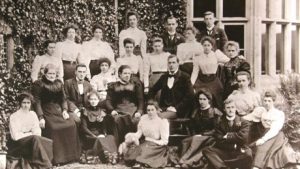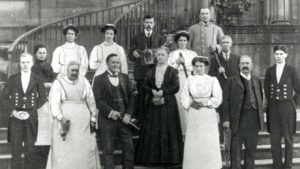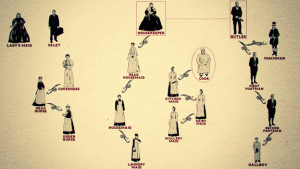The servants during the Victorian period were young girls between eight years to twelve or thirteen years.
Victorian servant’s duties
Most of the houses, including the middle-class homes, had servants and they formed an integral part of the household. The servants did jobs like washing clothes, washing the dishes and preparing meals and at times even took care of the children. During the Victorian times, there were servants who lived with the family they worked for and were provided with food and a place to live.

Servant life in Victorian times
In the early years of the 18th century, the servants used to sleep in the kitchen or at times in the cupboards. But as time went by, they were accommodated in a room that was small, cold, and had insufficient lights. The rooms had limited but basic furniture like a chair, bed, and wooden dresser. Initially, there were no holidays for the servants and they had to obtain the consent of their masters if they needed a holiday.
However, the permission could be taken back by the masters anytime they wanted servants. Around 1880, the servants were given half-day off on Sundays, and at times they were given an entire day off in a month. A change came in the 1900s when there was a fashion to give servants a break in the evenings which later on transpired to an entire day off per week.

List of types of servants
There was a hierarchy among the servants based on the job they did for a family. The Housekeeper was also known as Mrs. even if she was unmarried. She was at the top of the female servants and was responsible for maintaining the house and giving orders to the other female staff. It was essential that she had knowledge of accounts as she dealt with the expenses incurred while maintaining the house.
She was also required to make a note of everything in an accounts book. The House Maid was directly under the Housekeeper who was appointed to different positions like being a chamber maid, parlor maid, kitchen maid, laundry maid or in between maid, etc. The work done by these servants was excruciating. Other duties carried out by them included scrubbing the floor, brushing the carpet, beating rugs, filling lamps every day, and many other duties.
The Lady’s Maid was regarded as a more honored position as she was expected to be educated, have exceptional needlework skills, and be honest. She would help the Lady of the House dress and undress, style her hair, etc. She was expected to be pretty and preferably French.
Other servants were the Land Steward, House Steward, Butler, Housekeeper, Cook or Chef, First Footman, Second Footman, Footman, Head Nurse, Nurse, Under cook, Page of Tea Boy, Head Groom or Stable Master, Groom, Stable Boy, Head Gardener, Game Keeper, ground Keepers, Governess, Gatekeeper and lastly Scullery Maid.
The servants formed a crucial part of the functioning of the upper and middle-class houses during the Victorian period. Servants or the number of servants engaged by the upper or middle-class families were regarded as a status symbol and a sign of luxurious living.
Servants were engaged even by those who could not afford to have a huge army of servants. Though the job of working as a servant was taxing, many appreciated it as working as a servant gave them the job security that industrial work failed to give. The servants had their duties allotted and were required to wear a uniform.
Servants in middle-class families
In the case of families who were not so rich, the servants were responsible for all the household work from cleaning, and washing to taking care of the children. Women who had servants to do the chores were able to take rest during pregnancy and this increased their chances of survival after childbirth.
Housemaids were responsible for almost everything like lighting the fire, changing bed linens, drawing the curtains, etc. Then there were Dairymaids who milked the cows and churned butter. Nursemaids took care of the children which also included taking them out for walks.
There were servants who were called Parlor maids who answered the door, announced the arrival of guests, and served at dinner. Servants included not only the female staff but also the male servants and the Steward topped the hierarchical ranking.
The male servants consisted of footmen and pages who were engaged in jobs like trimming the lamps, carrying coal, serving meals, etc. The footmen would even accompany the family on their outdoor trips and served the purpose of a servant and a bodyguard.
The footmen were tall and these men were engaged especially because the guests and the employers favored tall footmen. The staff employed for the outdoor job included the coachmen and grooms, gardener, and at times even a gatekeeper. By the turn of the century, it was difficult to categorize servants, though the hierarchy was more or less the same in every house.
Victorian servants hierarchy

The Victorian era was marked by its rigid societal structures, which extended into domestic service. Large Victorian households, especially those of the upper class, employed a significant number of servants, each with distinct roles and responsibilities. The hierarchy among these servants mirrored the broader societal structure, with clear distinctions based on roles, duties, and proximity to the family they served.
- Upper Servants
- Butler: At the top of the male servant hierarchy, the butler managed the dining room, wine cellar, and pantry. He was responsible for receiving guests and often had a significant influence within the household.
- Housekeeper: As the highest-ranking female servant, the housekeeper managed other female servants and was responsible for maintaining the interior of the house, overseeing linen, china, and the household’s general cleanliness.
- Personal Servants
- Valet (Gentleman’s Servant): This male servant attended to the personal needs of the master, including clothing, shaving, and grooming.
- Lady’s Maid: Serving the mistress of the house, the lady’s maid helped her with dressing, hair styling, and other personal tasks.
- Middle Servants
- Cook: The cook was in charge of the kitchen, overseeing the preparation of meals. In larger households, there might be several under-cooks or kitchen maids assisting the main cook.
- Housemaids: They were responsible for cleaning rooms, making beds, and ensuring the household was tidy. Housemaids could be further divided into first housemaid, second housemaid, and so on, based on seniority and responsibility.
- Footmen: These male servants performed a variety of duties, including serving meals, answering doors, and running errands. Their roles were often ceremonial, and their appearance and stature were considered important.
- Lower Servants
- Kitchen Maid: Assisting the cook, the kitchen maid was tasked with simpler food preparation duties and cleaning.
- Scullery Maid: The lowest-ranked of the female servants, the scullery maid cleaned pots, pans, and did other basic kitchen tasks.
- Hall Boy/Boots: These young male servants performed a variety of basic tasks around the house and often acted as messengers.
- Outdoor Servants
- Coachman: Responsible for driving and maintaining the family’s carriage and tending to the horses.
- Groom: Looked after the horses, ensuring they were fed, groomed, and ready for riding or pulling carriages.
- Gardener: Maintained the gardens, plants, and the overall landscape of the property.
- Other Servants
- Nurse or Nanny: Responsible for taking care of the children of the household.
- Tutor or Governess: Employed in wealthier families to educate the children at home.
Conclusion
The hierarchy among Victorian servants not only provided structure to large households but also reflected the societal values and norms of the era. While the notion of such a rigid structure might seem foreign to modern sensibilities, understanding this hierarchy provides valuable insights into daily life, social norms, and the intricacies of the Victorian era.
- Liveried servants: The dedicated servants distinguished by their uniforms in historical eras.